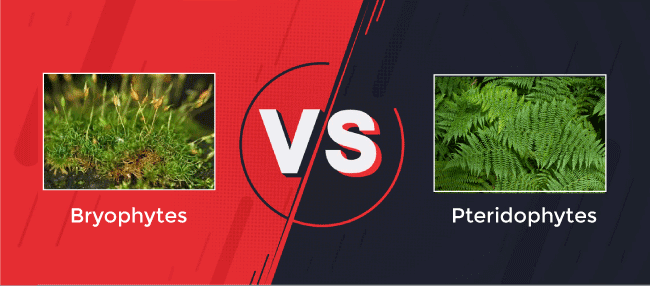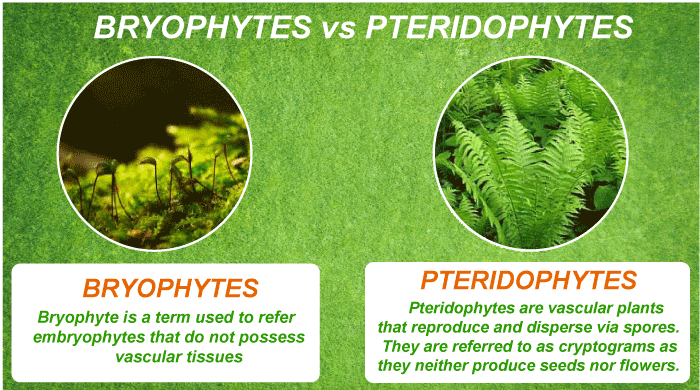Difference between Bryophyta and Pteridophytes

Bryophyta
Bryophyte is a term used in the plant kingdom to indicate or subgroup a particular type of plant. A bryophyte is a group of non-vascular plants that do not have xylem and phloem.
These plants are found in the shady and damp areas in which reproduction occurs, but due to dominating gametophyte plants, gametes production takes place but fails to produce flowers and seeds.
Pteridophytes
These are the division of plant, the vascular one differentiated into root, leaves, and stem. Leaves are called fronds. Tree ferns contain full trunks. Pteridophytes grow up to 30 m long, and fronds grow up to 4.5 m long.
In epical rain forests, ferns are epiphytes that grow on the trunks of other trees. Ferns have a highly specialized vascular system (the distinctive gap between xylem and phloem). Simple pteridophytes have single unbranched veins.
After flowering plants, pteridophytes are the most diverse group of land plants as they are close relative to seed plants, angiosperms, and conifers.
Pteridophytes hold an immediate position between phanerogams (seed plants) and bryophytes. Another name for the pteridophytes is cryptogram or vascular cryptogram. They cannot produce seeds, and flowers and vascular tissues are responsible for the supply of food and water throughout the plant. These plants also produce gametes. Therefore, they are called gametophytes, where plants' structures are described on the stem, roots, and leaves.
Pteridophytes classification
Pteridophytes are classified in two types:-
a) Lycophytes (lycopodiopsida)
These include club mosses, quillworts, and spike mosses.
b) Ferns (polypodiopsida)
These include whisk ferns, grape ferns, horsetail, marattiod ferns, and leptosporangiate ferns.
Let's learn about the key points that depict the difference between bryophytes and pteridophytes.

| Character |
Bryophytes |
Pteridophytes |
| Definition |
A subgroup of plant kingdom having leafy or thalloid plant body |
Pteridophytes are also part of the plant kingdom, having roots and stems |
| Examples |
Examples of bryophytes are hornworts, mosses, and liverworts |
Examples of pteridophytes are ferns, spike mosses, clubmosses, quillworts |
| Vascular tissue |
Absent Present |
| Vasculature system |
Vasculature system means xylem and phloem is absent in bryophytes |
Have a proper vasculature system (presence of xylem and phloem) |
| Roots |
Instead of roots, rhizoids are present, which help in anchoring |
Presence of roots |
| Stem or Leaves |
Absence of stem and leaves |
Presence of leaves or stem |
| Antheridium |
Salked |
Sessile |
| Archegonium |
Archegonium is fully exposed, whose neck is formed of six-row of cells |
Archegonium is partially embedded whose neck has only four rows of cells |
| Dominating part |
Dominating part is the gametophyte |
Dominating part is the sporophyte |
| Cell type |
It has haploid cell type |
It has a diploid cell type |
| Sporophyte |
This Phase depends on gametophytic |
This Phase is an independent autotrophic |
| Places |
Found at shady and moist places |
Found at the terrestrial environment |
| Highly reduced Phase |
Sporophytic |
Gametophytic |
| Stages connected |
Both stages, gametophytic and Sporophytic, are physically connected |
Both stages, gametophytic and Sporophytic, are not physically connected |
| Dependency |
For nutrition, the Sporophytic plant depends on the gametophytic plant |
Here Sporophytic plants are independent as they can perform photosynthesis. |
| Leaf |
Leaves are microphyllous without leaf gap |
Leaves are microphyllous or macrophyllous with leaf gaps. |
Similarities between both of them:-
- Presence of cuticle in both bryophytes and pteridophytes
- Both have a heteromorphic alternation of generations.
- Both are multicellular sporangia
- As per internal requirement, fertilization happens internally (because of the absence of siphanogamy)
- Sexual reproduction relies on the presence of monogamous in both types
- Both have male and female gametes where males are flagellated, and females are non-motile
- Presence of stomata and pores for gaseous exchange
- Sterile jacket cells cover the sex organs in both the groups
- In both types, antherozoids are present with the two terminal flagella
- The structure of antheridium and Archegonium is the same.
- For fertilizer, both of them need water.
- Both the groups have archegonia that possess neck and venter with neck-canal and venter canal cells.
- After the fertilization, the zygote is retained in the Archegonium, and fertilization and embryo development are the same in both groups.
- Bryophytes and pteridophytes have multicellular sporangia.
|


 For Videos Join Our Youtube Channel: Join Now
For Videos Join Our Youtube Channel: Join Now









